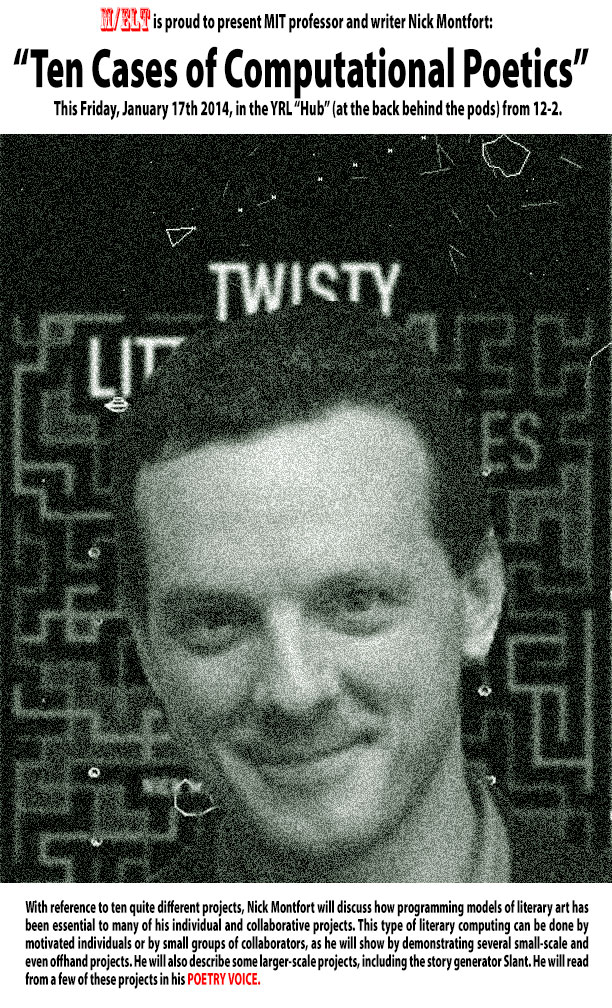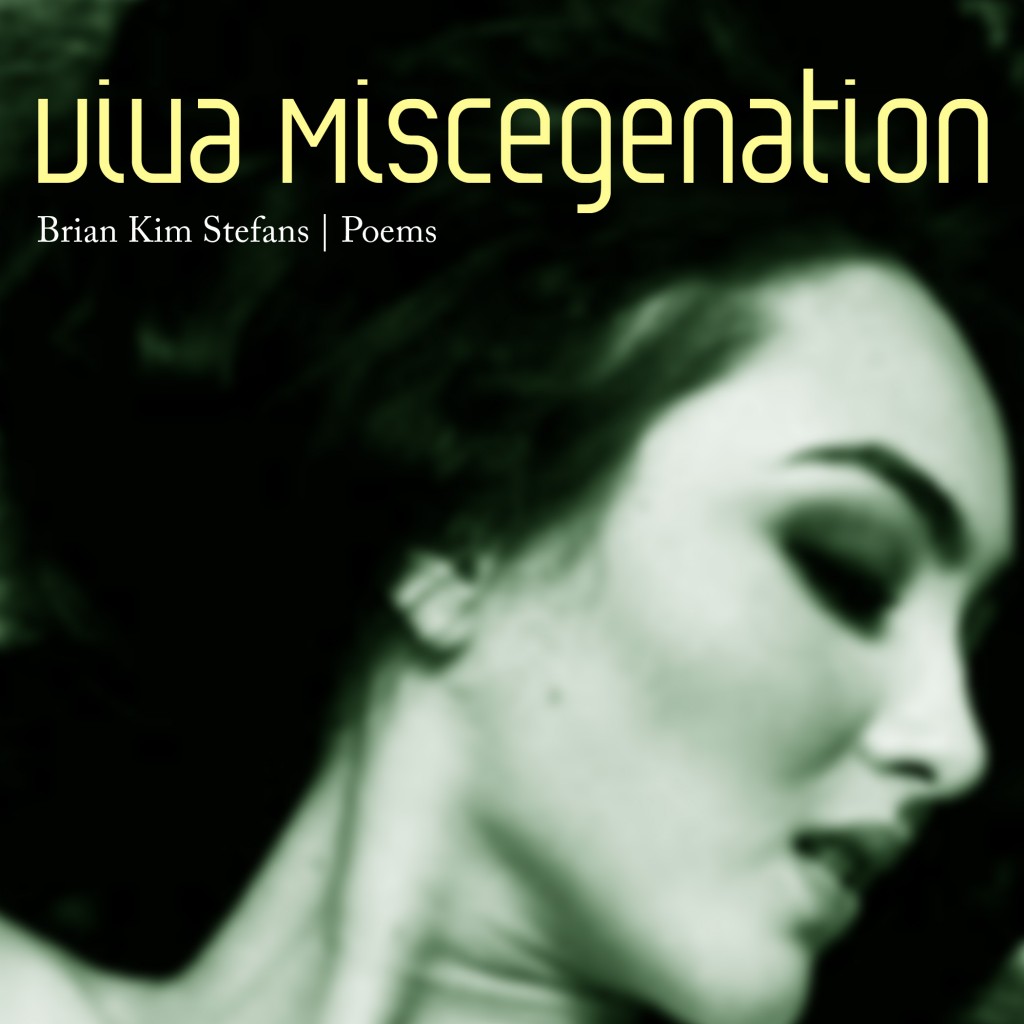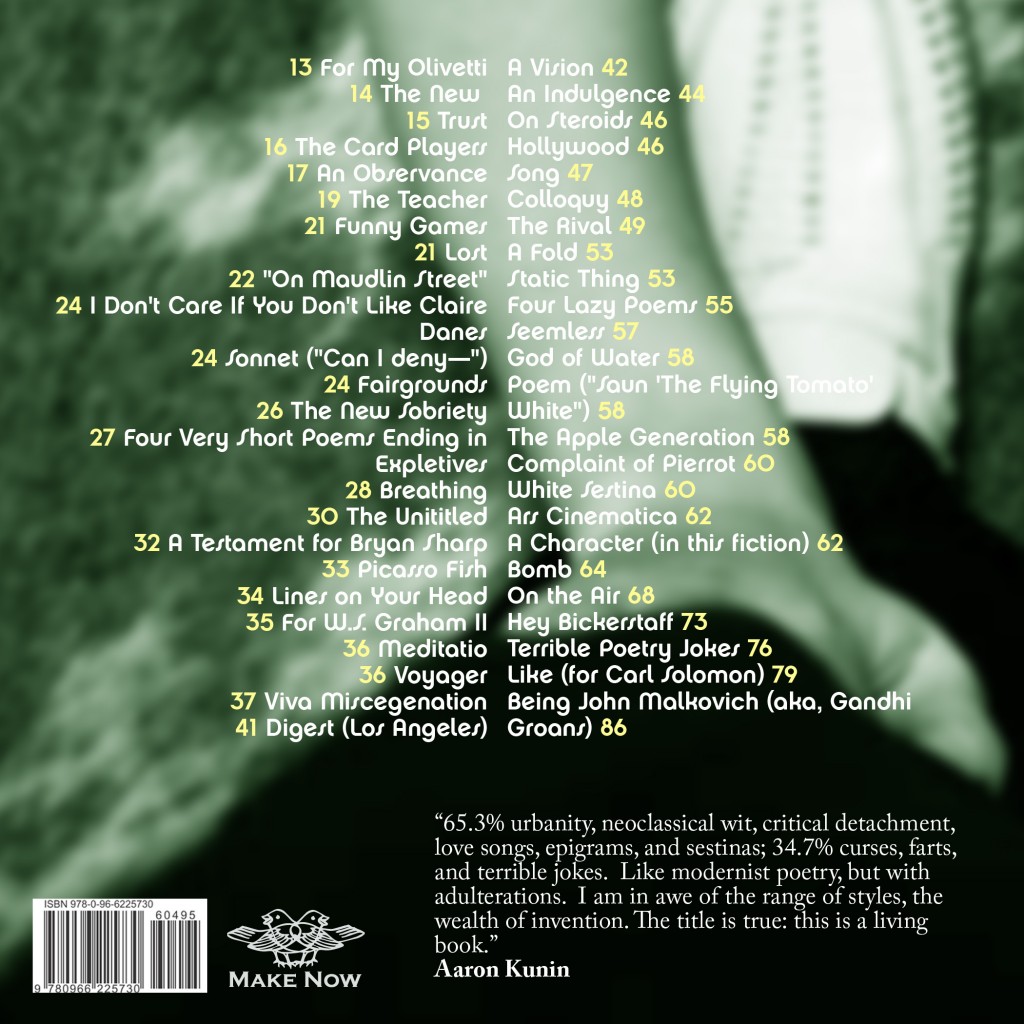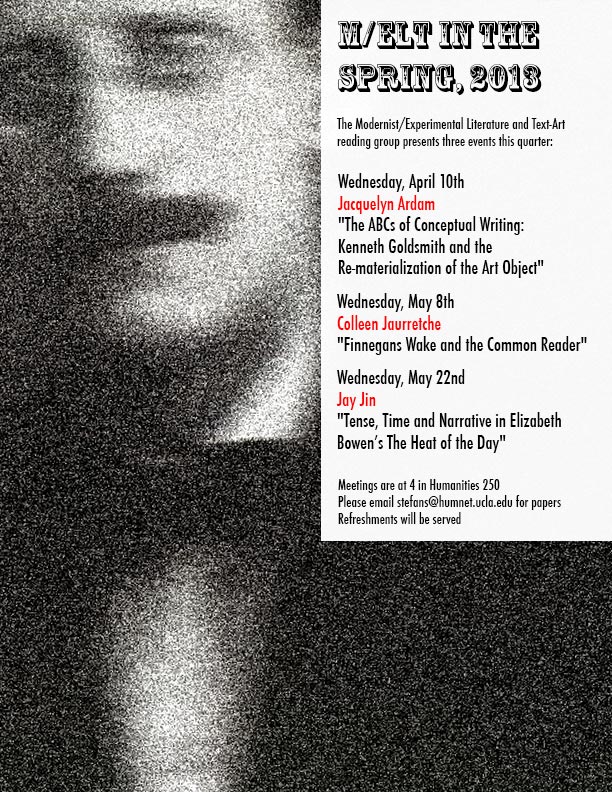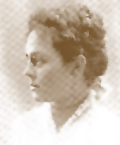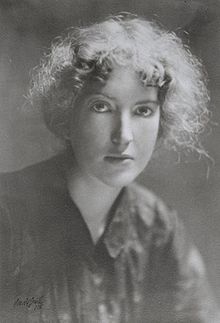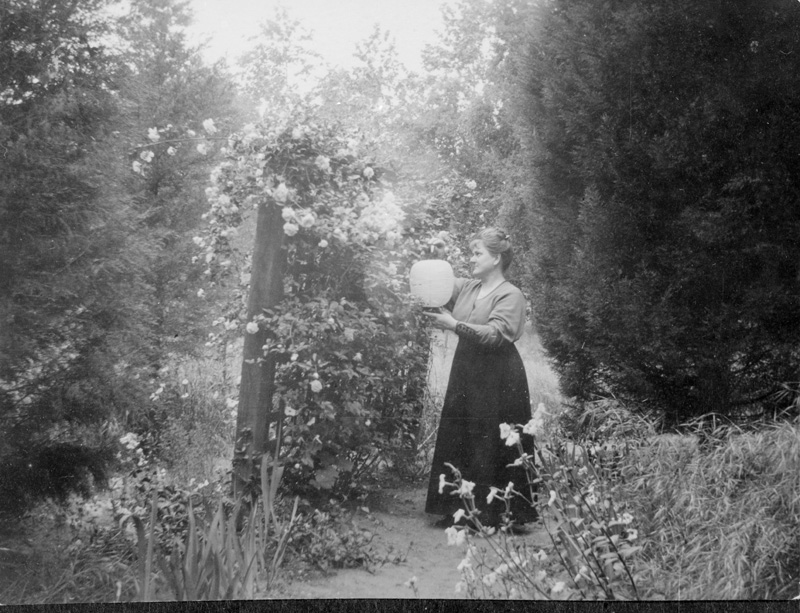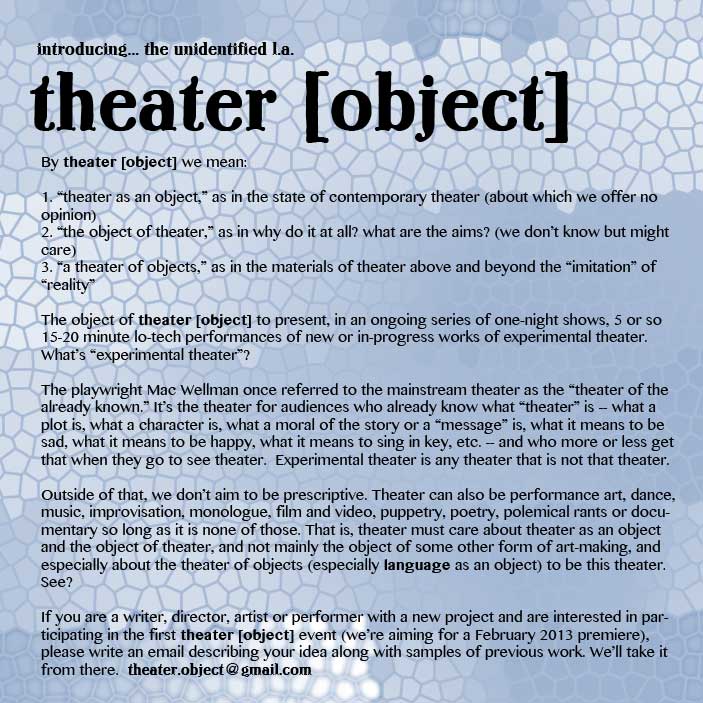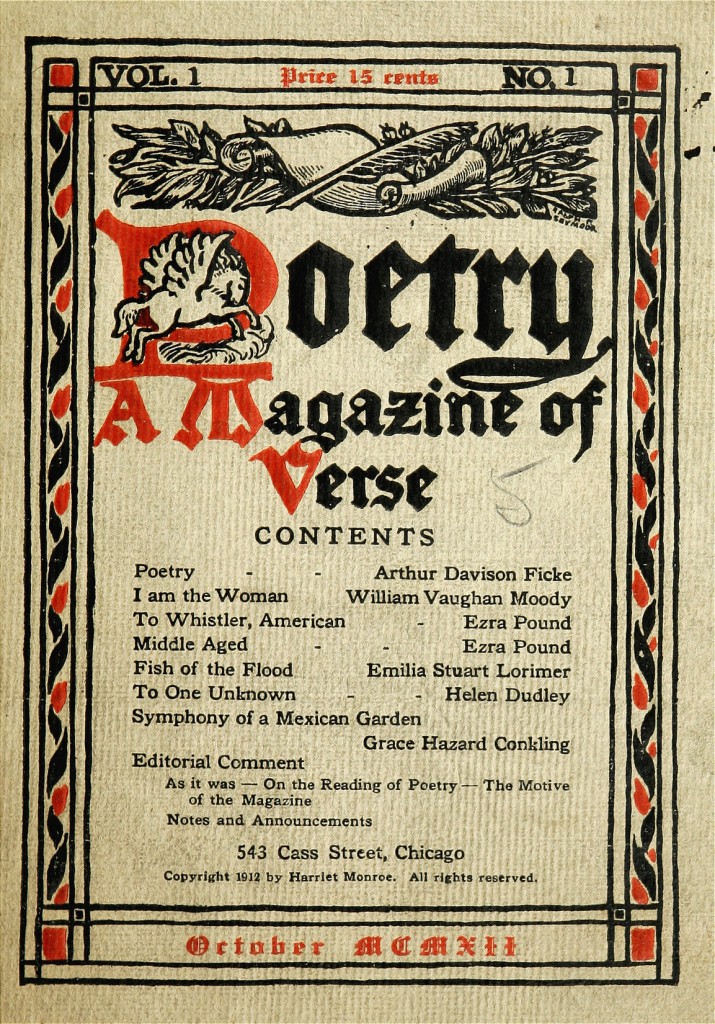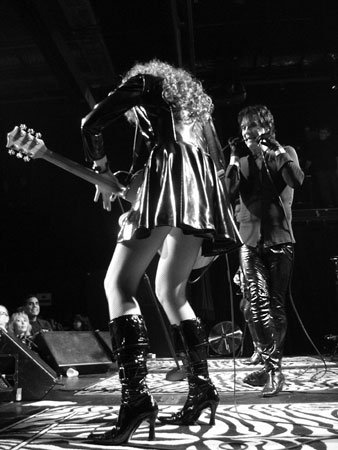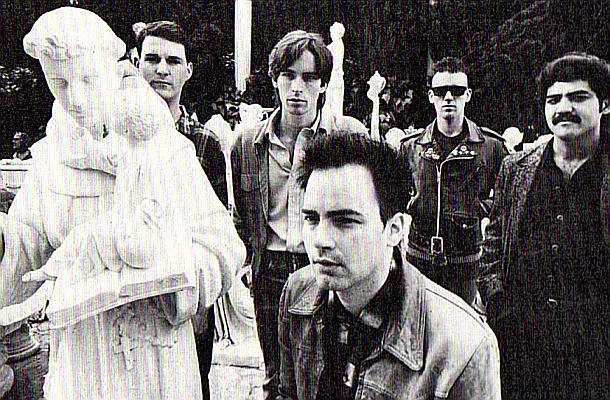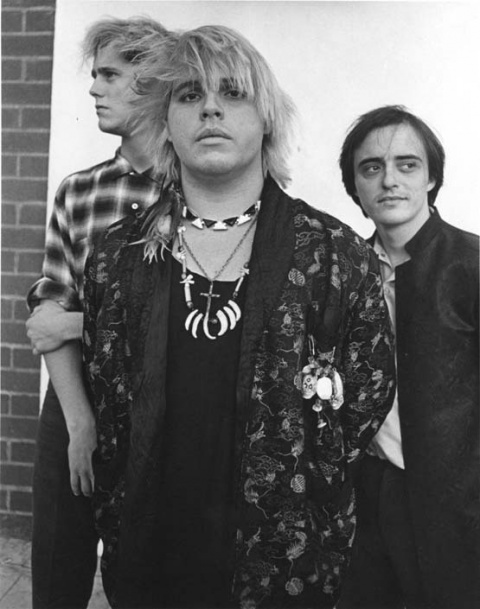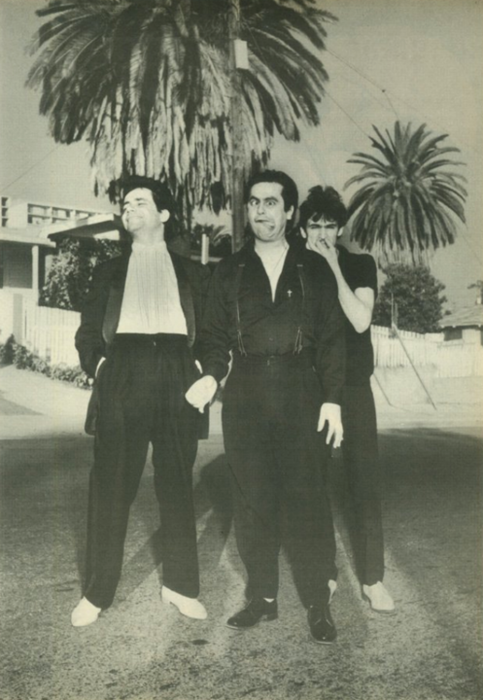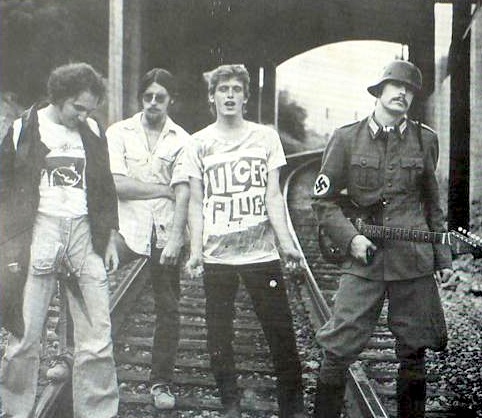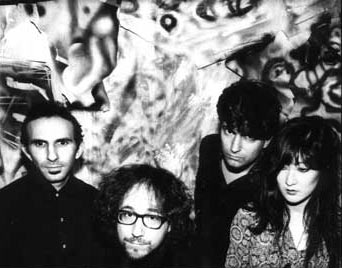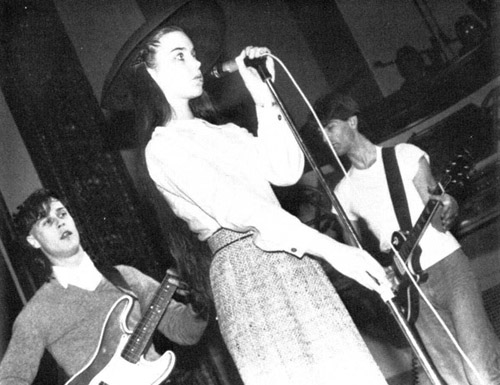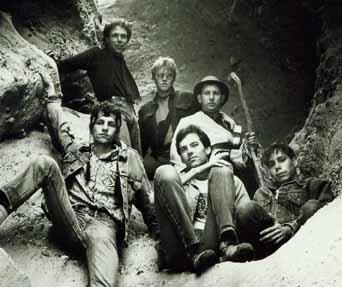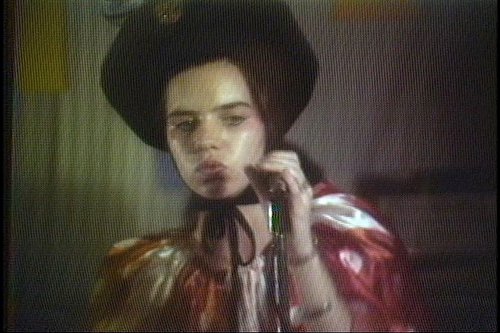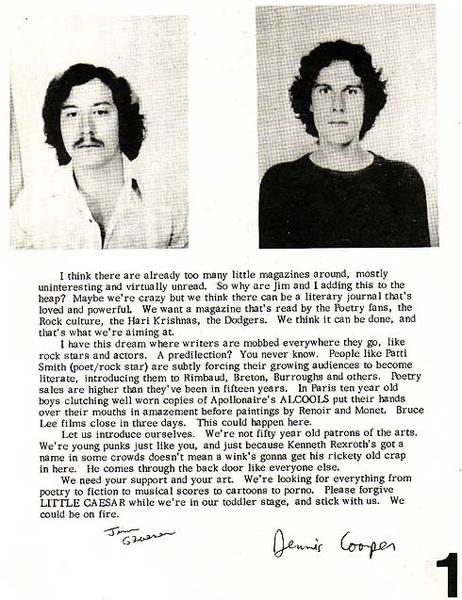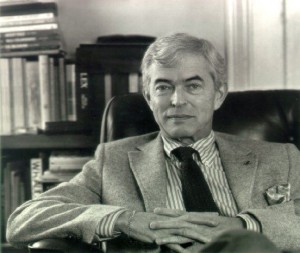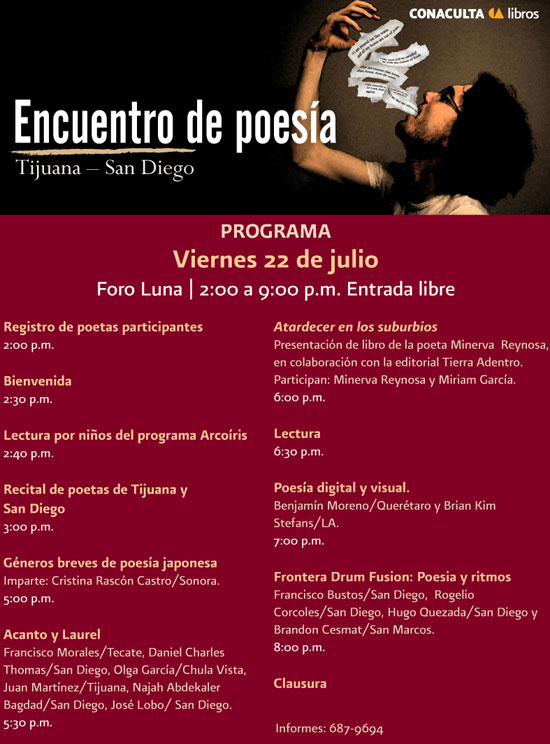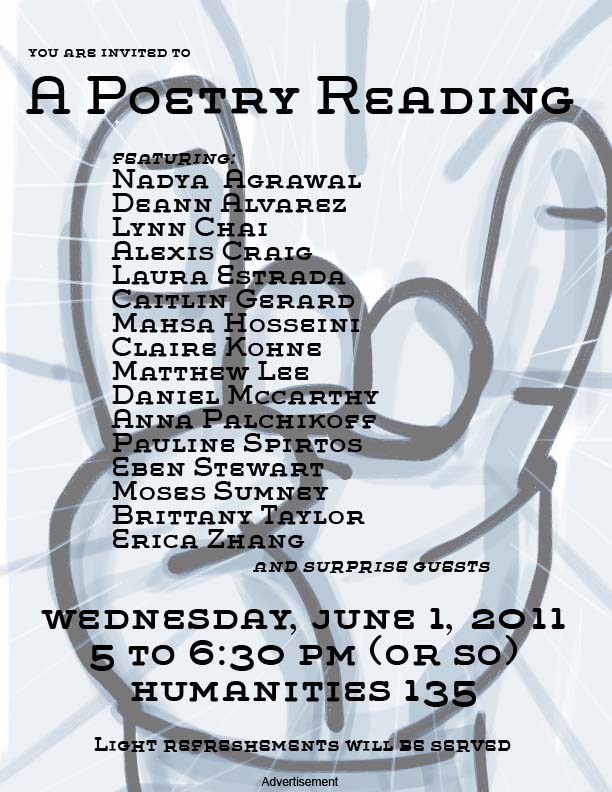Tue 14 Jan 2014
Tue 7 Jan 2014
The L.A. Telephone Book Vol. 2, 2012-13
Posted by bstefans under Design , Los Angeles Poetry[2] Comments
The L.A. Telephone Book Vol. 2 2012-13 is a collection of new work by contemporary Southern California writers and text-artists compiled and designed by poet and digital artist Brian Kim Stefans.
Including new work by:
Will Alexander
Diana Arterian
Thérèse Bachand
Molly Bendall
Guy Bennett
Byron Campbell
Geneva Chao
Andrew Choate
j.s. davis
Larkin Higgins
Erin Jourdan
Siel Ju
Janice Lee
Deborah Meadows
Béatrice Mousli
Dennis Phillips
William Poundstone
David Shook
Chris Stoffolino
Daniel Tiffany
AJ Urquidi
The volume is free for download from Mediafire (see links below).
The collection was created based on a semi-open call to writers and artists for up to 7 pages of work, set in 6 x 9 in .pdf format, which were then assembled into the present file. All choices were made by the artists and presented as they created it. Several artists contributed notes and statements about their work.
https://www.mediafire.com/?58d0d39mmv13bdy
Facebook page:
https://www.facebook.com/LATelephoneBookVol2
Sat 10 Aug 2013
This was the original cover concept for my recent book of poems “Viva Miscegenation,” just rediscovered it on my hard drive. Couldn’t use it because I couldn’t get permissions for the photograph. Liked the idea a lot, a book of poems designed like a jazz CD insert.
Sun 4 Aug 2013
Mon 29 Jul 2013
Lost Poets of Los Angeles: A Selection from Paul Revere’s Horse
Posted by bstefans under Essay , Los Angeles PoetryNo Comments
Here’s the selection of “lost” Los Angeles poets and first paragraphs of the intro that I edited and wrote for Paul Revere’s Horse. Included are poems by the Mexican poet Dantés, Nora May French, Olive Percival, Julia Boynton Green, Virginia Church, Alice Fowlie Whitfield, James Boyer May, Curtis Zahn, the music critic Peter Yates, John Thomas, super-masochist Bob Flanagan and Michélle T. Clinton.
Poetry in the United States is focused in two major urban centers, New York and San Francisco. While other cities have developed poetry “scenes,†it is these two cities that seem perennially able to renew their poetic identities, with fresh influxes of young writers and a substantial group of older, decidedly “established,†mentors to maintain a sense of continuity with previous generations and their aesthetic strategies. Other cities, such as Philadelphia, Boston, Washington, D.C., and Chicago, also have a number of writers with national reputations, and their traditions are old and deep, especially in the case of Boston, but none of them have risen to or maintained the status of a pole of activity, at least since the time of the New Americans, when an axis seemed to develop between New York and San Francisco. Of course, it is impossible to determine the exact parameters of a “major poetry city,†the term itself being inelegant, and writers in these cities (and others, such as Austin, Seattle, Lawrence, or Atlanta) don’t often sense a lack, or if they do, it is a productive one. However, these writers usually recognize that they are not in one of the cities associated with poetry—they identify as underdogs, loyal to their local scenes and perhaps even energized by their marginality.
A city not often counted in any of these rubrics is Los Angeles. One of the largest American cities, once dubbed the “city of the future,†it is legendary for its highways, the movie industry, miles of quasi-suburban “villages,†racial strife and wild economic disparities, and general air of being an outpost on the tail end of the country. It has also managed to nurture and sustain a number of poets who have attained national reputations, but nonetheless the city hasn’t acquired, to most eyes, an identifiable poetic “style†that illustrates to the readers of its poetry what the city means as an intellectual, artistic center, a stark contrast to the various styles of visual art—including the pop-inspired works of Baldessari and Ruscha, the architecture of Richard Neutra, the found art/assemblage aesthetics of Wallace Berman and Edward Kienholz, the performance art of Chris Burden, Paul McCarthy, and Mike Kelley, and the murals of ASCO—that have identified L.A. for decades. There are many reasons for this—there really aren’t many “older poets†active on the scene, for example, and many Los Angeles writers are quite happy to be working without an active local “tradition†anyway—but I won’t go much further on speculating why this is the case.
Sun 28 Jul 2013
Following are some paragraphs from an application to do work at the Huntington Library concerning three pre-war Los Angeles poets, Julia Boynton Green, Olive Percival and Nora May French. I’m sure all of you have heard of none of these writers (though if you have, please contact me immediately). More neglectorinos dug up during my research for the historical anthology of Los Angeles Poetry.
I came across Green’s poetry while researching another project, a historical anthology of Los Angeles poetry. I call the anthology “historical†because it will also consist of essays describing in some detail the various clusters of poets included. In Green’s case, she is part of an interesting early trio of women poets in early Los Angeles which includes Olive Percival (1869-1945) and Nora May French (1880-1907), both of whose papers are also collected at the Huntington. Unlike Percival or French, however, Green has never had a posthumous publication or reprints of her books, nor has she attracted the attention of scholars. I would also, however, like to look at Percival and French’s papers in case there is material that has been overlooked by past researchers.
Green was born Julia P. Boynton in New York, and spent the first 29 years of her life in New York State and traveling Europe. She published one book of poetry, Lines and Interlines, when she was 26. American Women: Fifteen Hundred Biographies, published sometime in the early 1890s, notes that she married Levi Worthington Green in 1890 and that, after their six months in Europe and a move to Rochester, “her literary work has been seriously disturbed by so many changes and diversions.†She moved to California in 1893, but she didn’t publish her next book of poems, This Enchanted Coast: Verse on California Themes, until 1928 in Los Angeles with the Times-Mirror Press over forty years after the publication of Lines and Interlines. Her final book, Noonmark, appeared in 1936, possibly self-published, out of Redlands.
I don’t have much more information about Green. The books’ acknowledgements pages note that she published in such journals and newspapers as The Boston Transcript, The Forum, The New York Times, American Poetry Magazine, Los Angeles Saturday Night, The Poetry Review (London) among a host of others that I’d never heard of.
Interestingly, toward her later years she published poems in the science fiction journals Weird Tales and Amazing Stories, largely because, I think, she wrote many satires concerning her dislike of modern life, particularly its machinery, but in the process managed to describe such speculative possibilities as whether someday airplanes, for example, might become sentient: “Will shrewd Invention, further, give the plane / A singing voice unknown to stork or crane?†she writes in “This Thing Incredible.â€Â “Prodigious Proxies†anticipates some of the concerns of Isaac Asimov and Philip K. Dick: “Will mutinous machines / Tread beauty, silence, peace, beneath their hooves / And, whether man denounces or approves, / Emerge the brutal end and not the means?â€
Green’s poetry from her first book, Lines and Interlines, while very interesting and formally accomplished, was not included by John Hollander for his amazing two volume anthology American 19th Century Poetry (Library of America), most likely because he had simply not come across her work due to her disappearance from the New York scene. This is unfortunate because much her poetry exceeds by far writing by many of the minor, since-forgotten figures he included. She took a very anti-modernist stance in her poetics—one poem, “Locoed,†rails against the arrival of free verse—and so her poetic style never much transcended what she had already developed in her youth; a taste for sonnets, ballads and rhyming couplets persists well into the 20th century. But the range of her concerns was wide; she wrote lovely, never trivial poems about nature, reflections on art and aesthetics, effective poems about love and death, narrative poems and, finally—what I find most original and fascinating about her—several anti-modern satires.
The website Archivegrid notes, tantalizingly, that the Huntington’s collection includes “correspondence, poetry, articles, stories, drama, and three unpublished books†by Green. Of course, I hope those three books are of poetry on a par with what has appeared, but I’d be interested new material of any genre. Consequently, another website lists a series of poems that she published after the appearance of Noonmark, some of which I’ve been able to locate, some not—drafts of these poems would be welcome.
My goal is to assemble a book, if not of a “complete†poems, then of a selection. I’d like to include whatever prose about her literary community, her writing practices and her views on poetry and writing that I can find. Green represents something quite important to Los Angeles poetry; she is the earliest English-language poet I can find, in fact, who has a substantial body of work that rises much above the level of the derivative material by the countless other L.A. poets of the time and could have a national audience. Green is distinctly Californian, if not an Angeleno, in her preference for the quiet pleasures of her garden over what must have seemed the terrible encroachment of technology on everyday life, most interestingly as it descends from the air. Even as I write I hear the sound of a propeller plane overhead, nothing compared to the occasional swarm of helicopters which regularly descend on my Hollywood neighborhood—Green might have been the first to complain of such things in poems! Though she falls somewhat into the tradition of Los Angeles boosterism inaugurated by the newspaperman Charles Lummis to encourage emigration, she is never less than detailed in her attentions to plant and animal life on the “enchanted coast,†and is never governed by anything but her own impulses to create and respond to the world.
I’d also like to research the papers of Nora May French, an intense poet who committed suicide at the age of 27. The Outer Gate: The Collected Poems of Nora May French appeared in 2009 from Hippocampus Press, which usually focuses its attention on writers in the H.P. Lovecraft circle. While French didn’t write science fiction or “weird†verse, her circle of writers during the last year of her life in Carmel included George Sterling and a few others who crossed over into the uncanny. French’s poetry is much denser than Green’s, more visionary, and, as her early suicide might suggest, pained and impatient. I don’t think there are any more surviving poems—her mother apparently destroyed all of her lighter, humorous verse because she thought it would hurt French’s reputation as a writer—but I’d love to take a look anyway.
Olive Percival, known largely as a collector, travel writer and designer of fabulous gardens (the Huntington has published a book of her designs) published two books of poems as well as a series of memoirs. One of Percival’s books, Leaf-Shadows and Rose-Drift (1911), anticipates some of the Asian-inspired stylistics of major Imagist poets like Ezra Pound in his book Cathay (1915). I haven’t been able to locate her second book, Yellowing Ivy, published the year after her death in 1945. While my least favorite aspect of her book of Asian-influenced poetry are the rhyme schemes—it’s unfortunate that she didn’t discover or embrace free verse—I’d love to see whether she either moved past her Asian mode, past her devotion to fixed rhyme schemes3, or if not, developed the method of her first book into something more substantial.
I haven’t contacted a press yet about the poems of Green, but I am in discussion with a few presses about the historical anthology itself. Consequently, I’m working on a series of essays for the Los Angeles Review of books on my various “clusters†of L.A. poets which should start appearing over the next year. In 2011, I published a selection of “lost†L.A. Poets in the San Francisco journal Paul Revere’s Horse. It included two poems French, two by Green and three by Percival in that selection—I can give you a copy for your archives if you’d like.
Mon 8 Jul 2013
 I was asked by Marissa Lopez, my colleague at UCLA, to write the introduction to a symposium (really just a public chat session with music critic Nikki Darling and Jose Maldonado of the Sweet and Tender Hooligans, a Smiths tribute band) concerning Latinos and Emo, probably because of my love of all things Morrissey. This is it, pretty light stuff and written rather quickly but I hope you like:
I was asked by Marissa Lopez, my colleague at UCLA, to write the introduction to a symposium (really just a public chat session with music critic Nikki Darling and Jose Maldonado of the Sweet and Tender Hooligans, a Smiths tribute band) concerning Latinos and Emo, probably because of my love of all things Morrissey. This is it, pretty light stuff and written rather quickly but I hope you like:
Introduction to Lat/emo
May 31, 2013
Over the past three or so years I’ve been researching the LA post punk scene, collecting whatever free music is or was available online, going through the used record bins at Amoeba and Counterpoint and various other places in LA, and making a ton of online purchases at sites like Discogs and Musicstack.
My interest in post punk as a genre of music was spurred by Simon Reynolds Rip It up and Start Again which charted the histories of such bands as Joy Division, Devo, The Associates, Scritti Politti, Pete Ubu and others that formed on the cusp of, or in some cases prior to, the punk music explosion of ’77.
My knowledge of LA music, outside of the mainstream either of the early 70s (Fleetwood Mac, Tom Waits, Jackson Brown, etc.) and of the later hair metal era (Mötley Cru, Guns n Roses, etc.), was mostly confined to some punk and hardcore, and even at that it was quite limited — Black Flag and X might have been the only LA punk bands I could have named when I got here.
Soon I discovered such lost gems as the Screamers, Suburban Lawns, the very obscure Null and Void and the even more obscure Wild Kingdom — whose only recording was published as a flexi disk insert for a music fanzine (Brad Laner has a rip of it on the website for his radio show).
From Pasadena, most of Wild Kingdom was made up of Latinos — you can see them on YouTube from their appearance on Peter Ivers new wave theater (the sound is awful) — but that is only worth noting for the rather elaborate pompadour, leather jacket and suede shoes of their lead guitarist. Wildly experimental, I don’t hear too much Chicano influence in their music; the track, “Roma/Destiny,” starts as ebullient space music with one of the most unusual drum beats I’ve ever heard, to something like carny music, then back to space music again.
[The video below is from their appearance on New Wave Theater with horrible sound. The track “Roma/Destiny,” their only studio recording, is a thousand times more interesting but you get a sense of their appearance and instrumentation here.]
I focused on post punk also because that’s kind of the music of my youth — and not punk, which predates me a bit and besides was a little too aggressive for my sensitive poetic soul in my teen years (I was also an MTV kid, and punk never really broke there). So my goal, really, was to uncover whatever music in LA that matched up with that post punk aesthetic — experimental, sophisticated but still DIY, at once political and concerned with emotions and solitude, and wildly imaginative (costumes, make-up, synths and videos shot in exotic locations — and which didn’t make it across the country to New Jersey.
I was surprised at how many musicians of color — Latino but also a fair amount of Asians (Dianne Chai of the Alley Cats, Susan Rhee of Susan Rhee and the Orientals, a woman who goes by the name of Cyrnai) and even black presence (notably Pat Smear but also a ska band called the Untouchables and, of course, Fish Bone) — were on the scene, if not at the start, then later.
Not surprisingly, perhaps, it was really in the Latino music (with the exception of Fish Bone) that one heard a real cross cultural mix — not in every song, perhaps, but overtly at moments and maybe as a subtle undercurrent of pining after, or critique of, the American Dream that is buried deep in the mix and the lyrics but which decidedly reflects the attitudes of generations of Latino US culture. Not nihilism but an allusive poetry, not just critique from the outside but politics from within the margins.
East LA had its own club, The Vex (started by Willie Herron of Los Illegals) partly to address the fact that most east LA bands outside of the Plugz and, later, Los Lobos couldn’t get gigs on the Strip. The Vex clubs became a meeting place for the punk bands and the more traditional Mexican music that had a young audience (a good compilation of this music is Los Angelenos – the Eastside Rennaissance, which includes the Plugz, the Brat among other obscure acts).
Probably the Chicana musician most associated with the LA punk scene is Alice Bag, born Alicia Armendariz, front woman of the band the Bags. I haven’t read her autobiography, Violence Girl : East L.A. Rage to Hollywood Stage, A Chicana Punk Story, but reviews show her story to have been, indeed, quite violent and not a little inspirational.
Bag might better remembered as a great charismatic figure in the early days of punk — she did in fact wear bags — though the recordings of the music I’ve heard (mostly live tracks) seem to fit the punk, and not post punk mode I was looking for. She’s featured in Penelope Spheeris documentary about the LA punk scene The Decline of Western Civilization though after the band had broken up — she left music to become an educator.
But I think the most important bands for the purposes of a conference on Latino emo would be the Plugz and the Brat. The Plugz were far more accomplished — their first LP, Electrify Me, which features their punk version of La Bamba (which figured in the Repo Man soundtrack) was full on electric guitar-bass-drum punk. I’ve lost my copy of this LP so couldn’t review it (neither the Plugz nor the Brat feature — surprise! — on Spotify).
Their second, Better Luck, features better production and more accomplished songwriting — Tito Larriva, their lead singer and songwriter, could fit easily among the “angry young man” post punk generation of the likes of Bruce Springsteen and Elvis Costello — as well as the inclusion of horn sections, entire songs in Spanish, complex harmonies, and pastiches of various styles of music such as reggae, a kind of jerky Devo-ish beats, jangly pop and traditional Mexican.
Larriva’s lyrics are poetic, including humorous reflections on So-Cal life in the 70s such as waiting on a gas line — the outro to that tune pleads “Don’t light a match! Don’t light a match! Don’t light a match!” etc. — watching unattainable, if slightly sketchy, girls on a hot day on the street (which he recorded for an important album of spoken word poetry in LA), the tale of an American who “took the bait” (I think a critique of mindless capitalism), and somewhat gruesome evocations of having a brother involved in violent street crime, slot throats and all.
This sort of mix seems not inimical to Morrissey himself, who could often mix politics, ethics, infatuations with the life of crime and erotic longing in a single song. Larriva — who also had a great voice, not the most versatile tool but distinctive, an urban existentialist singing through the clenched teeth of a gangster — went in to form Cruzados, Tito and Tarantula and others and he is also known as an actor in Roberto Rodriguez films and elsewhere. He’s also scored films.
Lesser known is Teresa Covarrubias, lead singer of the Brat (other members included brothers Rudy and Sidney Medina), which only managed to record an EP for Larriva’s own label, Fatima records. Covarrubias is described as being introverted and yet dynamic on stage – one website states: “Covarrubias remembers that sometimes audiences were surprised by her off-beat yet alluring stage presence and didn’t expect much from someone so petite, brown and seemingly timid.â€
Covarrubias’ lyrics (I’m assuming she wrote them, I don’t have credits for the LP) could also vear from the political to the personal quite quickly — one song called “The Wolf” has as its refrain “The wolf and the lambs… we are the lambs” and sings of “democracy laced with hypocrisy” while “Attitude” could be a high school anthem — it seems entirely about declarations of personal identity, an emo theme if there ever was one — and “Starry Night” is a love song.
The structures aren’t quite as sophisticated as the Plugz — very much four part punk (one track clocks in at 54 seconds) with some X influence — but are terribly effective, especially due to Covarrubias’s clear but expressive voice rising over the hard electric din (it resembles Belinda Carlyle’s in this way, a little flavorless but, in juxtaposition to the intense lyrics and clanging music, just right), some nice rhythm guitar work and background vocals. It would be truly a loss if they were able to work past this early sound in later years and yet never found a contract.
Los Illegals are also a hugely important East LA band but maybe I don’t see their connection to emo as clearly. Formed as a wing to the art/political collective ASCO, they seem a little less personal, less vulnerable than the Plugz or the Brat. No less imaginative – some of their songs have a sci-fi apocalyptic or noirish intensity — they are never personally introspective, though of course I think introspection of a sort — social introspection based on communal fear and rage? — lies at the heart of their most satiric songs, like The Mall and Guinea Pigs.
Besides, I’ve spoken long enough! I’m eager to learn more about the infamous Latino fanbase for the music of the Smiths and Morrissey — it all makes sense to me now but I confess it was surprising when I first learned of it back in new York!
Wed 26 Jun 2013
Tue 25 Jun 2013
 |
| Su Tissue, Suburban Lawns (Photo: Bruce Kalberg) |
204 Great City — Night Flight to Tangiers (1986) 5:05205 The Toasters — Teenage Tease (1980) 3:59
224 Peter Ivers and David Lynch — In Heaven (1977) 1:46225 Nip Drivers — You Need Us (2000) 1:10
Sat 11 Aug 2012
By theater [object] we mean:
1. “theater as an object,†as in the state of contemporary theater (about which we offer no opinion)
2. “the object of theater,†as in why do it at all? what are the aims? (we don’t know but might care)
3. “a theater of objects,†as in the materials of theater above and beyond the “imitation†of “realityâ€
The object of theater [object] to present, in an ongoing series of one-night shows, 5 or so 15-20 minute lo-tech performances of new or in-progress works of experimental theater. What’s “experimental theater�
The playwright Mac Wellman once referred to the mainstream theater as the “theater of the already known.†It’s the theater for audiences who already know what “theater†is — what a plot is, what a character is, what a moral of the story or a “message†is, what it means to be sad, what it means to be happy, what it means to sing in key, etc. — and who more or less get that when they go to see theater. Experimental theater is any theater that is not that theater.
Outside of that, we don’t aim to be prescriptive. Theater can also be performance art, dance, music, improvisation, monologue, film and video, puppetry, poetry, polemical rants or documentary so long as it is none of those. That is, theater must care about theater as an object and the object of theater, and not mainly the object of some other form of art-making, and especially about the theater of objects (especially language as an object) to be this theater. See?
If you are a writer, director, artist or performer with a new project and are interested in participating in the first theater [object] event (we’re aiming for a February 2013 premiere), please write an email describing your idea along with samples of previous work. We’ll take it from there.
Thu 9 Aug 2012
The L.A. Telephone Book is a collection of new work by contemporary Southern California writers and text-artists compiled and designed by poet and digital artist Brian Kim Stefans (that is, me).
The volume is free for download from Mediafire (see links below).
The collection was created based on a semi-open call to writers and artists for up to 7 pages of work, set in 6 x 9 in .pdf format, which were then assembled into the present file. All choices were made by the artists and presented as they created it. Several artists contributed notes and statements about their work.
Mediafire download
PDF (33mb)
http://www.mediafire.com/?gxqkj7fw39lndkn
ZIP (30mb)
http://www.mediafire.com/?yu6d5w9pq32322m
Facebook page:
https://www.facebook.com/TheLaTelephoneBookVol1
This volume includes work by:
Harold Abramowitz
Amanda Ackerman
Danielle Adair
Will Alexander
Rae Armantrout
Therese Bachand
Julia Bloch
Allison Carter
Andrew Choate
Selby Cole
Brent Cox
Zen Dochterman
Ben Doller
Sandra Doller
Amy Dozier
Johanna Drucker
Kate Durbin
Sesshu Foster
Matt Gangi
K. Lorraine Graham
Anna Guercio
Larkin Higgins
Jen Hofer
Jibade-Khalil Huffman
Andrea Lambert
Janice Lee
Eric Lindley
Tess. Lotta
Barbara Maloutas
Andrew Maxwell
Anna Mayer
William Mohr
Joseph Mosconi
William Poundstone
Christopher Russell
Anthony Seidman
David Shook
Irene Soriano
Brian Kim Stefans
Mathew Timmons
David L. Ulin
Paul Vangelisti
Mark Wallace
Jacqueline Waters
Christine Wertheim
Amanda Yates
Sat 14 Jul 2012
I’m writing in response to Juliana Spahr’s and Joshua Clover’s self-nomination to the presidency of Poetry Chicago. I was especially struck by how they noted that the outgoing president was critical of MFA programs and the fact that poets often got jobs in universities these days. The letter got me thinking of ways to spend their money to provide some at least temporary support for poets who are otherwise working in non-academic fields, how to decentralize poetry in the U.S. and move it away from the major cities on the coasts, and, how to get poets from other, less-visited countries over here and vice-versa. Most these are, I think, pretty original ideas with the exception of the last. I’m serious about all of this, by the way (no snark today, sorry)!
1. Travel grants for poets to non-European countries
What are the poets in Ghana doing these days? I’m a little surprised at how American poets gravitate to Paris for their big cultural sojourn, as if it were still 1917 and the frontiers of Europe lay along the Swiss Alps. I think it would be far more interesting if poets, especially those interested in politics, travelled to Africa, Asia and South America – many of the countries there are in what one might call “transition†periods, and if anything provide a more dynamic view of globalization (not to mention capital) in the present times. England, France, Germany and Italy (though this last, being a semi-permanent basket case, still has something to offer) don’t provide much of a contrast to how things work in the States, and we have access to their literary histories through tons of translations and visitors from abroad. The Clash might have been bored with the U.S.A., but I’m bored with the E.U. I just think it would be more interesting for poets to travel to the frontiers of their cultures, where things are broken or breaking down and something of the world  system lies exposed, than travel the paths they are expected to travel, being sophisticated beings, and which are often already gloating over their recognized achievements. For what it’s worth, I don’t particularly care for poetry that is inspired by beautiful places, it’s often quite self-involved, since what is there to think about in beautiful places than one’s self? Consequently, tickets to places like Senegal, Peru and Thailand are super expensive compared to the tickets to Europe, and there is not much coming back from the other end in terms of invitations or grants, so a poet would especially need help there. I also wonder why political radicals from the left travel to Paris, as if May ’68 were still flowering in the boulevards, rather than places that have had revolutions much more recently. Is it really that much more interesting to read Badiou in a Parisian café than at home?
2. Seed Grants for semi-commercial poetry/arts organizations in non-major U.S. cities
One of the success stories in New York has been Bob Holman’s Bowery Poetry Club, which combines a heavy list of readings, music concerts, and other events with the commercial income of a bar and coffee shop. I think that could be a model for similar organizations in cities that don’t have a lot of funding for their native literature and art scenes and which are in need of places where poets and artists can socialize, kick back, get to know each other’s work and love or loathe it, etc. This organization – perhaps housed in some small building on some weird, forgotten edge of town that is sketchy but safe, but still inexpensive – could also serve to help bring poets in from out of town, or maybe act as a link in the chain of places that poets travel to when they do book tours. I have no idea who I would call if I were to do a cross country tour, or whether it would be worth it at all – driving to Austin for 12 hours to have 3 people show up? This organization could keep a few rooms on the second floor as crash pads for travelling poets, or even have residencies like they do here at Machine Project, having a poet come to stay for a month or so to give workshops or just be part of the scene. It would be great if New York were not the only place poets gravitate toward (or are encouraged to gravitate toward) after graduating from college (or high school, or whatever). Why couldn’t it be Pittsburgh, Lawrence or New Orleans? I imagine that the proposals for these grants would spell out a 5 year plan, including costs and income. There would not be any requirement to describe how the organization could last in perpetuity – I just don’t imagine any poet really wanting to run a business for the rest of his/her life – just how it would last for 5 years, to get something in going in said small city.
3. Upgrade internet knowledge and distribution of books
The Small Press Distribution site is really incredibly useful, and certainly an improvement over the days when you ordered books from them by telephone or mail. But what I’d really like to see on the site are some new features that allow those of us who never get to see these books browse with some knowledge of what’s inside them. I think it would be great if SPD made available at least 5 pages of all of their books on their site, thus facilitating browsing, and also creating something of an unedited, ever-expansive online anthology of contemporary poetry. Presses would just get in the habit of including a short sample PDF when sending their information in. SPD’s bestseller lists, for example, often contain poets I’ve never heard of or worse, the same poets that I’ve heard of who have appeared on every SPD bestseller list. The blurbs and press information often are completely non-informative, and having staff picks is nice, but still, I often don’t know the staff. I often buy tons of SPD books when I see them at book fairs, but almost never, unless for classes, from their site. And poets don’t always write the same way they did in previous books — imagine the disappointment fans of the “Waste Land†felt when they opened their copies of “Burnt Norton.†I just assume that every time I publish a book, people just think it’s another Free Space Comix and say, nah. I also think it would be great to have a part of the site (or maybe just a separate site) that is entirely automatic for presses that are so small that they can’t even afford to pay the nominal fee it requires to be distributed by SPD. For example, if I were doing a press run of say 50 copies of such and such a chapbook, I could go to the site, fill out a form, upload a cover image and sample pages and a link to the website where I could purchase the book. All SPD would have to do would be to somehow make sure that no one just uploads pure garbage, pornography, links to sites selling bogus hair growth tonics, or even just links back to blogs for those self-promoters, etc. and also that old entries that link to dead sites are deleted.
4. Grants for poets from other countries to travel to the U.S.
Once again, I’m interested in having poets from non-European (or at least the more or less affluent European countries) come to the United States to study, get involved with a poetry scene, publish or translate their work, share the work from their own respective country, etc. Even poets in Mexico find it incredibly expensive to spend even a few weeks in New York city, so you can imagine what my imaginary poet from Libya, Georgia or, the Philippines might feel. One of the great things about living in New York was being able to meet so many great artists from other countries – one of my favorites was an Israeli butoh dancer named Boaz Barkan, whom I met through the remarkable and terribly missed Stacy Doris – and though I occasionally have the opportunity to meet artists (but mostly students) from other countries in Los Angeles, it’s obviously with far less frequency. I suspect that there are forms of this sort of grant, but my guess is that they involve some sort of research aspect, whereas I think these poets should be able to come to the States based purely on their creative achievements. Another thing I would like to see which is somewhat related are grants for non-English speaking or writing residents of the United States. There is a whole network of South American poets here that might be receiving support from their respective home countries, but are often (I sense) not feeling terribly integrated into the U.S. scene. This grant wouldn’t operate as a way to make a living, but more as a fund to get work translated into English, to travel, to create community, much like what is outlined above. It would be great to foster non-English U.S. poetry if only to provide a more realistic, less homogeneous, image of what this country is. I would imagine that in the Korean American community, for example there are some pretty good poets over here writing in Korean who wouldn’t be able to published in Korea but who should be read, somewhere.
5. A permanent “poets in need” fund
This is certainly my least original suggestion, but I’ll describe it (at length) anyway. As it is, those of us in the poetry community periodically receive requests from the group Poets in Need for donations to be given over to a usually older poet who has fallen on hard times. In some cases, there are direct appeals to the community on behalf of someone who is pretty well-known and beloved. This is all really great, though I know that, in the past, when second parties have made appeals on behalf of a poet, said poet was not always so happy to see their misfortunes advertised, and/or were too proud to accept donations from their friends. I think it’s great that the network of poets could help each other out, but quite often the poets being appealed to are not themselves all that rich. Consequently, I imagine there are many poets that simply don’t have that sort of network, or who might be are not necessarily “beloved†– I just mean poets who are anti-social and don’t get out much, or poets who are simply to young to have published much but who have, say, become desperately ill and have no insurance – or who simply do not like to make public their personal problems or finances. There are poets who are also pretty much in a terminal state of poverty due to illness and age, but who cannot foresee themselves appealing to the community every time the gas bill needs to be paid. I think a grant or some sort of social security for poets who have significant publishing histories or have otherwise proved their commitment to poetry (through translation, editing, rabble rousing, etc.) should be able to have a place to receive some funding should they hit upon hard times. A corollary to this could be an education or training grant for poets who either don’t have any skills in anything more than, say, word processing or copy-editing and want to get themselves out of a hole.
Well, that’s my fifteen cents. I’m sure I’ll think of more just after publishing or posting this, but hopefully there is something to chew over here and Poetry Chicago will respond. I really want them to, since they really are in a position to do something really radical and interesting, but I’m afraid they’re just going to throw their money at the usual places, like fostering more small presses, or get poetry into the schools type programs, all of which is good but in the end doesn’t make poetry more interesting (and Pound, who you see above, was all about making poetry more interesting, not simply getting people to read it).
Notice that none of the above has anything to do with affiliations with poetry schools, movements or well-established poetry “wars.” If anything, I’d like to see a situation where more poets unconcerned with, however much informed of, the familiar partisan battles are engaged in writing, editing and publishing. I don’t think it’s a required element in the education of a poet to suddenly become aware of the largely inane bickering about the mainstream or “school of quietude” and some sort of avant-garde. Let these “political” ideas, some of which are useful, come after the exposure and engagement with the work, not before. I mean, having an opinionated poetry clique is a nice way to make friends and foster one’s self-education, but  can sometimes set irrational boundaries on what one is expected or not expected to read.
Also, none of this has to do with selling or making poetry more popular with the “masses.” I hate those campaigns to somehow save poetry from obscurity and showing the public that poetry is something that can be a part of their lives. The poetry that I generally like will most likely never be very useful to your average American, just as I’ll never see a Gang of Four song covered on American Idol. Just let the poetry get written, get out, and if it finds its readers, great, if not, then let it rest for a few decades to be rediscovered by someone with taste! Poetry’s not dying, it doesn’t need resuscitating, it doesn’t need help by well-intended people involved in more lucrative industries who often simply don’t know what they’re talking about. And please, let’s get rid of the position of Poet Laureate!
Tue 22 May 2012
Los Angeles Post-Punk Underground (c. 1977-1987), Vol. 3
Posted by bstefans under Los Angeles Post-PunkNo Comments
So this collection has been getting quite a few hits lately, thanks to an appearance on BoingBoing and a lot of tweeting and shouting. Thanks to everyone who has forwarded the link and downloaded the tunes. Various band members have been appreciative in comments an in emails as well — it’s been great fun hearing from them.
Like the past collections, this one has a few oddities. On a whim, I decided to include a track from Neil Young’s “electronic†album Trans, a sweet one written, purportedly, for his autistic son who apparently responded more directly to the vocoder voice than to an unmodified human one. Also a little strange will be the two tracks by Peter Ivers, the first from one of his solo efforts and the latter the ditty he wrote for David Lynch’s first feature Eraserhead. Ivers was, of course, the host of LA’s New Wave Theatre on which many post-punk bands appeared. He was murdered in his apartment in 1983 in a still unsolved case. One occasionally hears about a Peter Ivers’ cult revival, and I must say I find much of Terminal Love, from which this track is taken, pretty great.
The track from Aurora Pushups might sound anachronistic — some of the members of this band played in Zolar X — but I find it really catchy. The B-side, “Victims of Terrorism,†was included on Jon Savage’s Black Hole Califironian Punk 1977-1980, and they are if anything more out of place there than here.
There’s also a cameo by ex-Dead Boys singer Stiv Bators, who moved to LA in an effort to become a punk-pop singer. Well, it’s part of the history! Seemingly out of place will be Phranc, the self-described “All-American Jewish Lesbian Folksinger,†but I thought to include her due to her previous membership in Nervous Gender (included in the first volume) and because I saw her open for The Smiths at Jones Beach back in the day.
Several bands have appeared in earlier volumes of this collection: Gleaming Spires (who, by the way, formed as the backing band of Sparks in the mid-70s) with their most famous tune “Are You Read For the Sex Girls,†whose video is incredibly boring and well worth watching; 17 Pygmies with another catchy tune with a female vocal; two tracks from the art collective Monitor, the second sounding like a cover of an ancient African ritual, and Outer Circle, the A-side from their second, final EP which could have been a hit if it were more professionally produced (and didn’t have such odd, misogynistic lyrics). The singer of Outer Circle, Steve “Spit†Spingola, went on to sing for the Fontanelles, who are best known for a track featured in the movie Hobgoblins; I prefer the track here over that one.
Also included are a few tracks from the ever-resourceful Steaming Coils and Freshly Wrapped Candies, another funk rap by Rand Kennedy, one final track from Null and Void (members of whom, by the way, worked on the first Berlin album), a bouncy one by Human Hands, a dark one by the Shadow Minstrels, and Cipher, this one with a strong, Siouxsie-ish vocal track. This collection starts with a very concrète Kommunity FK, who I’m beginning to think were terribly underrated — they only managed two LPs before last year’s La Santisima Muerte which I hear is very good.
While it’s never quite clear where the Cramps should be placed, geographically, they were originally from California and did record most of their records here, hence their inclusion. I never listened to them when I was younger but am now a huge fan. 45 Grave are often credited with starting the deathrock movement with their cover of “Riboflavin-Flavored, Non-Carbonated, Polyunsaturated Blood,†and I prefer the earlier, Darker Skratcher version to the glossier one from their LP. Pompeii 99 is kind of an earlier manifestation of Christian Death, joinging Rozz Williams after Rikk Agnew departed; this is one of their goofier tracks.
Running through this collection are a number of tracks by woman performance artists — Marina La Palma (is this title really Esperanto?), Marnie Weber, and most infamously Johanna Went. Marnie Weber (whose earlier band, the excellent Party Boys, are twice represented here) has sporadically recorded several LPs over the years, as well as having gained a reputation as a sculptor, film and video artist, costume designer, painter, etc. You can visit her website to find out more.
Partly Cloudy could almost be called a female performance act, as most of their tracks involve a sort of spoken comedy routine by vocalist-musician Aliz over some very compelling, industrial-ish backing tracks. Not unlike many LA bands included here, they seem not to have recorded anything past this first LP. I can’t find much else about them on the net.
The Gun Club are a well-known band that I wasn’t going to include since they seem a bit “roots†rock to me, but there’s no way to hear these tracks without thinking they are a bit too spastic to be traditional. Pop Art are the only “jangly†pop band that I know of from LA that cannot be associated with the Paisley Underground (outside of the Three O’Clock, most of that genre’s music leaves me a bit cold, but I’m trying…). The very psychedelic Drowning Pool recorded a handful of LPs and EPs, and I’m looking forward to hearing more of them as I love the weird, seemingly Yes-inspired “Festival of Healing.â€
What I know about the rest of the bands here — Blissed Out Fatalists (who seem to have stolen a page from Jesus and Marychain’s playbook), Infantry (I really wish I had a better version of this track), Puppies (from San Diego), Cathedral of Tears, Shiva Burlesque (who actually have a substantial catalogue), Mnemonic Devices, Subjects (who I think might be from San Francisco…), Transport, Bone Cabal, Readymades and Burning Image is so pathetically little, I’ll just let you hear the songs and Google them if you want to learn more. I can tell you that if-then-else is basically The Weirdos doing an all synth album, and there is a nice post about Wog over at A Viable Commercial. Their LP sounds like it was recorded in a bedroom with a Casio keyboard, but actually many of the tracks are pretty compelling.
I’ll be slowly working on a volume 4, most likely the last one, over the next couple of months — new bands appear all the time the more I dig — so please stay tuned.
Disk 1
1 Kommunity FK — Incompatible Disposition (1983) 2:48
2 Neil Young — Transformer Man (1982) 3:23
3 Party Boys — Nora (1986) 3:53
4 Drowning Pool — Festival of Healing (1987) 2:56
5 Peter Ivers — Sweet enemy (1974) 2:46
6 17 Pygmies — Suit Of Nails (1985) 3:35
7 Gleaming Spires — Are You Ready for the Sex Girls? (1981) 3:59
8 Marina La Palma — Mi Ni Parolas (1984) 2:51
9 Blissed Out Fatalists — Everything & Nothing At All (1987) 3:03
10 Phranc — One O’ The Girls (1985) 4:58
11 The Cramps — Green Fuz (1981) 2:08
12 Infantry — The Call (1987) 3:50
13 Monitor — Amphibious (1981) 3:10
14 Wog — I Had a Notion (1988) 5:54
15 The Gun Club — Devil In The Woods (1982) 3:05
16 Outer Circle — My Mona Lisa (1984) 3:53
17 Pop Art — Never No (1987) 2:31
18 45 Grave — Riboflavin-Flavored, Non-Carbonated, Polyunsaturated Blood (1980) 2:38
19 Stiv Bators — Evil Boy (1979) 3:17
20 Puppies — Mechanical Beat (1981) 2:45
21 Human Hands — Jubilee (1981) 3:59
22 Cathedral of Tears — Calm Storm (1984) 3:00
23 Mnemonic Devices — Marriage Of Convenience (1982) 3:42
24 Freshly Wrapped Candies — Cherry Tomato (1989) 2:22
Disk 2
25 Shiva Burlesque — Arabesque (1990) 5:14
26 Pompeii 99 — Android Police (1982) 3:00
27 The Fontanelles — Passion Kills (1987) 2:57
28 Steaming Coils — Carne De Sol (1991) 2:59
29 Drowning Pool — The Italian Pop Song (1990) 5:37
30 Rand Kennedy — Smith’s Room (1983) 2:24
31 Null And Void — Un Sedatif Ce Soir (1980) 4:34
32 Cipher — Body Chemistry (1981) 2:09
33 Marnie — Everyone Loves Olga (1988) 3:09
34 Monitor — Mokele-Mbembe (1981) 3:23
35 The Gun Club — Preaching the Blues (1981) 3:59
36 Subjects — Augie (1982) 2:36
37 Transport — Body Buildings (1982) 3:49
38 Bone Cabal — I O Betulah (1983) 4:34
39 Shadow Minstrels — The Guest (1983) 2:30
40 Partly Cloudy — Bus Ride (1987) 3:16
41 Aurora Pushups — Angels on Runway (1978) 2:54
42 Readymades — Terry Is A Space Cadet (1977) 4:18
43 Burning Image — Time Is Running Out (1984) 4:09
44 Party Boys — I Love You (1986) 3:22
45 if-then-else — Sidewalker (1981) 5:23
46 Johanna Went — Slave Beyond The Grave (1981) 2:50
47 Peter Ivers — In Heaven (1977) 1:46
Fri 27 Apr 2012
Los Angeles Post-Punk Underground (c. 1977-1985), Vol. 2
Posted by bstefans under Los Angeles Post-Punk[2] Comments
This new set starts with a track well out of my date range from the great band Steaming Coils, but I though starting with some carnival sounds would give some symmetry to the collection, pointing back to the Wild Kingdom track from the first group. We then move into The Plugz, one of the great first-generation punk bands of LA, from their mellower second album Better Luck. A Mexican-American band, the Plugz incorporated a variety of musical styles into their work, one of the rare LA bands that seemed to want to do that, Tito Larriva being an excellent and ambitious songwriter whose since moved on to score a few films.
Geza X is something of an LA legend, perhaps best known as a producer, though his early band The Deadbeats recorded some classic tracks (one included here), and he himself was a pretty compelling, if very strange, performer with his band The Mommymen. Rikk Agnew is another legend of sorts, being a member of Adolescents and recording with the first incarnation of Christian Death. These two tracks are taken from his first solo album, All By Myself, on which he played all the instruments. These might seem out of place in a “post-punk” collection being largely rock music — the second, slower track could have been a b-side from an early Kinks single — but in fact I think this LP is a bit uncategorizable and somehow bridges punk with something more melodic, even a bit grandiose.
Acts that appeared on the first collection include Suburban Lawns (one seemingly inspired by the percussion of Eno-era Talking Heads), Null and Void, Life After Death (where the Roland Butler really comes out), Trotsky Icepick (formerly known as Danny & The Doorman — sucks when you hit on a great name for your band just after the first album release), Abecedarians (including their Bernard Sumner-produced first single, released by Factory), the Fibonaccis, Atila (again, not sure if this is a great track or pointless), Human Hands, Green on Red (sounding more Lou Reed-ish than ever), Savage Republic, Gleaming Spires, Shadow Minstrel and Freshly Wrapped Candies. My choices from the Kommunity FK and Christian Death catalogues haven’t been terribly inventive, but so there.
The Outer Circle track here starts a bit slow but leads into a killer slide guitar solo and ends with 4-minutes of synthesizer bliss. The second track I’ve included is, I believe, in 5/8 time, which I’m only guessing based on the drummer’s countdown at the beginning. There’s also another BPeople track, and a sweet, sincere bit by Passionel, Alex Gibson’s project after BPeople folded. I’ve also included another unreleased track by Perfect Imperfect Circular, Bill Shifflett’s project after BPeople.
So that leaves the newcomers, who include the Earwigs (I’ve only been able to locate 4 tracks by them, two of which are actual songs), Cipher (an instrumental that is pretty haunting, though most of their work involves Siouxsie-ish vocals), and Primal Danse, who only managed an EP with Enigma Records (and doesn’t even appear on Discogs). The track from Knife Lust appears on a collection of Devo covers created by radio station KROQ which appeared (I believe) even before or in the same year as the release of the Q: Are We Not Men? A: We Are Devo!
IQ Zero managed to release a single (can’t find much else about this band) whereas the synth- and vocoder-drenched Android (full name: Android A 21st Century Band), most of whose tracks border on kitsch, managed a single and an LP. Boxboys were the first ska band in LA, and inspired a mini-movement here leading to the more prolific Untouchables.
That leaves the track from the inimitable Zoogz Rift, mostly known for wild, often beautiful, often profane Beefheart-ish work. Fourwaycross are little late in the chronology, and most of their work seems to edge toward prog-rock, with a few tracks sounding like mid-career Pink Floyd.
I’ve also included a track from Bad Religion’s often maligned (even by the band itself), but often hotly-defended second LP, which introduced synthesizers into the equation. The track from The Screamers is from a series of demo sessions, and might best be heard in conjunction with the video. The Child Molesters were really an LAFMS-based conceptual band, a fake punk-band led by a bunch of guys who didn’t much like punk (hence the Nazi garb in the photo below). They’re kind of like a cross between the Fugs, witch their obscene humor, and The Homosexuals, at least in inspired offensiveness of their band name.
That leaves the folk singer Cindy Lee Berryhill with a track taken from on of the Radio Tokyo compilations, and which I think is weird enough (and not quite as retro as might first seem) to include in this collection. The Weirdos are usually associated with the first wave of punk acts though they mostly considered themselves an “art” band (their if-then-else project of industrial instrumentals would seem to bear that out). The Egyptian Lover is a DJ coming out of the electro-funk scene in LA and is often considered a forerunner of hip-hop.
The set closes with an anachronistic cameo by Jobriath, the ill-starred solo artist whose first album was so over-hyped and glammed out (a little late in the day) that it completely bombed. He released another LP (which his label practically refused to promote) and eventually succumbed to AIDS in 1983. I kind of think of him as the forebear of vulnerable, histrionic acts like Antony and the Johnsons and (from a skewed angle) Kiki & Herb. Morrissey label Sanctuary released a best of, Lonely Planet Boy, in 2004.
Disk 1
1 Steaming Coils — Singing Notice (1991) 3:12
2 The Plugz — El Calvo Y La Cruz (1981) 2:57
3 Cipher — Harmonic 33 (1981) 3:07
4 Geza X And The Mommymen — The Paranoids Are Coming (1982) 3:11
5 Bad Religion — Chasing the Wild Goose (1983) 2:50
6 Null And Void — All The Old Humans (1980) 3:36
7 Life After Death — Isn’t It Time (1985) 2:57
8 Suburban Lawns — Baby (1983) 3:59
9 Rikk Agnew — 10 (1982) 2:58
10 Atila — De-pre-ssion (1985) 4:38
11 Trotsky Icepick — Mar Vista Bus Stop (1988) 3:03
12 Abecedarians — Smiling Monarchs (1985) 6:47
13 Android — Perpetual Motion (1982) 5:28
14 IQ Zero — Zero Gravity (1981) 3:09
15 Outer Circle — Broken Children (1982) 7:02
16 Primal Danse — Insomnia (1982) 5:00
17 Perfect Imperfect Circular — From The Ocean Above (1986) 4:09
18 The Plugz — Touch For Cash (1981) 2:40
19 Fibonaccis — Crickets (1987) 4:32
20 Knife Lust — Shrivel Up (1979) 3:10
21 The Screamers — 122 Hours of Fear (1978) 3:32
22 The Child Molesters — Brenda Spencer (1981) 1:44
Disk 2
23 Christian Death — Cervix Couch (1984) 3:10
24 Shadow Minstrels — Popular Song Of The Hour (1983) 4:23
25 Suburban Lawns — Not Allowed (1981) 2:20
26 Green on Red — A Tragedy (1981) 4:20
27 Kommunity FK — The Vision And The Voice (1985) 3:48
28 Human Hands — New Look (1982) 2:44
29 Boxboys — Separate Rooms (1980) 3:12
30 Savage Republic — Mobilization (1982) 3:21
31 Abecedarians — Soil (1986) 6:08
32 Gleaming Spires — How To Get Girls Thru Hypnotism (1982) 3:56
33 Outer Circle — Blind Venetians (1982) 1:39
34 Zoogz Rift — The Breather (1986) 4:22
35 BPeople — Give Up (1980) 2:02
36 Freshly Wrapped Candies — Fa Fa Fa (1987) 3:11
37 Deadbeats — Brainless (1979) 2:31
38 Fourwaycross — Apologize (1985) 4:18
39 Rikk Agnew — Everyday (1982) 4:30
40 Cindy Lee Berryhill — Headin’ For The Border Line (1987) 3:56
41 Earwigs – Freedom (1981) 2:47
41 The Weirdos — Helium Bar (1991) 3:22
42 Passionel — I Found You Crying (1984) 3:25
43 The Egyptian Lover — I Cry (Night After Night) (1984) 5:04
44 Jobriath — Heartbeat (1974) 2:45
Thu 19 Apr 2012
Los Angeles Post-Punk Underground (1979-1987), Vol. 1
Posted by bstefans under Los Angeles Post-Punk[3] Comments
So here’s the distillation of my “post-punk” anthology of Southern California bands. I’m having a hard time finding a truly accurate title for the comp, since many of the bands are from the county but from places with very particular scenes, like Pasadena and Long Beach, and a few are from outside of the city altogether (but within a two-hour drive). And to call these “post-punk” bands is not entirely accurate; many of them are “new wave,” “darkwave,” “deathrock,” “art rock,” even something like “freak folk.” Oh well.
Some older bands are included, like Zolar X and Sparks, since they might be the strongest native influences (outside of Zappa or Beefheart and local groups like LAFMS and COMA) and seemed somehow to respond the post-punk/new wave phenomenon. I’ve included early tracks by bands that have gone on to produce hits, like Oingo Boingo and Wall of Voodoo, since they just seemed part of the scene back then and are certainly strange enough (and also more original than a lot of the Devo/Cure/U2 etc imitators that I’ve come across). Some acts, like Missing Persons, Berlin and the Motels, for all their presence on the scene, were quite commercial from the start and are so well known that I’ve skipped them.
Of special note is the first track, by Wild Kingdom, since this is their only studio track and was released as a flexi-disk insert in a short-lived music magazine called No Mag. It’s pretty amazing — I can’t find anything else by them except an appearance on Peter Ivers’ New Wave Theatre which isn’t very good (but you get an introduction to their eccentric drum kit). The band was almost entirely Chicano, and one of the guys even sports an exaggerated Elvis-pompadour.
Other bands I could only find single studio tracks for are Dogma Probe (who also has a great video), the Beat-E-O’s (who kind of remind me of the Homosexuals), and Animal Dance, whose track was retrieved from the Radio Tokyo compilations that appeared in the 80’s. Other live, more dissonant, tracks by Dogma Probe appear on their website.
The groups that managed to record and A and a B-side include the Nu-beams (though an entire live bootleg appears on the net) and the Squad (or “S Squad”) which I retrieved from the CD of the Keats Rides a Harley compilation. Bands that have 4-8 song EPs to their credit include Shadow Minstrels (this is their slowest, most conventional track but give it time), Plebs (forgive me for this one), In Living Color (a bit of an imitation “Madchester” band in my mind, right down to fake, Richard-Butler-esque English accents), Standard Living (whose track here seems to anticipate that George Michael single I can’t remember the name of), Wet Picnic (fronted by the well-known Argentine film composer Gustavo Santaolalla) and Human Hands (though they’ve put out posthumous LP compilations and have started recording again).
Perfect Imperfect Circular, Bill Shifflette’s project after Null and Void, didn’t release anything, and though these tracks seem rough, the songs veer from hook to hook, with no looking back, much like the earlier band, if with a little more soul. Rand Kennedy has a lot of comp appearances and a cassette only collection, “Scenes from Redemption,” all of which sound roughly like this one — spoken word over background beats. League of Nations put out a single EP that sounds something like a stripped down Another Green World (an earlier project was titled Oblique Strategy), that is, sans Phil Collins and Robert Fripp. Afterimage, probably one of the more conventionally “post-punk” bands here, only managed an EP and a few singles as well, though their tracks can be found on all sorts of comps.
I’m not sure I can take Atila all that seriously — their records are terribly under-produced, but they managed to put out two full-length LPs, the first of which, International Sandwich, featured lo-fi imitations of music styles from around the world. Monitor was a weird, Throbbing Gristle-like art collective called World Imitation Productions that decided to become a musical act. A nicely designed .pdf outlining the history of the band appeared somewhere on the web but I can’t find it, so you’ll have to settle for this. They also have a strange appearance on New Wave Theatre.
One of my favorite acts here, Outer Circle, who managed 2 EPs, was fronted by Steve “Spit” Spingola, who appeared on New Wave Theatre as part of an act called Heroic Struggles, which was quite hilarious (it’s since been deleted). All of their tracks are really great but for some reason I’ve only included one. Martyr Complex used to include the “All-American Jewish lesbian folksinger” Phranc, but she doesn’t appear on their album; the band also went by the name of Nervous Gender, and featured Paul Roessler of the legendary LA synth-punk band the Screamers, whose videos for “122 Hours of Fear” and “Vertigo,” are priceless. Fronted by the legendary, late Tomata Du Plenty, The Screamers never recorded an LP, possibly due to unrealistic ambitions (an interview with Jon Savage).
Danny and the Doorknobs, something of an underground super-band (composed of members of 100 Flowers, The Last, Leaving Trains, etc.), transformed into Trotsky Icepick and a had a career well into the nineties. I’m sure many readers are already familiar with Christian Death, first fronted by Rozz Williams, who then left only to form a band called “Christian Death” several years later while the first one was (and still is, fronted by Valor Kand) active. Kommunity FK only recorded 2 LPs in the 80s but seem to have reformed; they also belong to the “deathrock” category though I’m really suspicious of these taxonomies.
Iron Curtain, a band that can mix leaden drum tracks with depressing lyrics and So-cal harmonies, was an act from Santa Barbara, fronted by Steven Fields who is still active with an act called Cosmic Love Child. “Legalize Heroin,” the only track to break the 1987 cut-off date, was a solo track but really feels like Iron Curtain’s swan song, and is I think the most accomplished (and enigmatic) thing they released. Null and Void, another one of my favorite acts, released a smattering of LPs, cassettes, singles, etc. of varying quality. I’m still trying purchase a copy of their first LP, which I’ll soon snatch off of Ebay. I think some members of this act went on to play with Berlin.
Savage Republic has a substantial discography, mostly long, percussive-heavy, unchanging but atmospheric, Middle Eastern or African tinged instrumentals that must have been amazing live. Their cover designs, titles and general iconography are really great. The poppier, more synth-heavy side of some of their members appeared as 17 Pygmies; this track reminds me of a long-lost 80s band Torch Song who were featured in the same issue of Debut as The Smiths. Green on Red is known as a “Paisley Underground” band, but this track, from their first EP, seems to me strange enough to belong on a post-punk compilation.
The Fibonaccis has a fairly substantial discography and seems to vary between somewhat campy but virtuoso, Casio-keyboard send-ups of traditional music styles and really elegant art-rock songs; with a little more edge, they would have been perfect for John Zorn’s Tzadik label or onstage at the Knitting Factory back in the 90s. Another “art rock” act is BPeople, who were among the more visible on the LA scene; Alex Gibson went on to form Passionel and then record as a solo artist. On the fringes are the most “arty” projects, Steaming Coils and Freshly Wrapped Candies, the majority of whose output resembles LAFMS improvs with tape effects. I’ve considered including more of this type of material but some of it seems so aggressively anti-song that it broke the spirit of the collection.
The Abecedarians were known well enough to catch the attention of Bernard Sumner (of Joy Division) who produced their first single “Smiling Monarchs” for Factory, the flipside of which is “Benway’s Carnival” (included here) and neither of which are very emblematic of their work. More typical is the brilliant “I Glide,” with its minimal lyrics and subtle transitions in the guitar lines. Chris Manecke used more delay than the Edge, but unlike the latter’s band, the Abecedarians thrived on their apsergersy stoicism.
The Suburban Lawns were probably the first post-punk, or New Wave act, from LA to get national attention when the Jonathan Demme-directed video for “Gidget Goes to Hell” was played on Saturday Night Live in 1979. Their first LP spawned “Janitor,” which has a pair of appearances on Youtube, the first a proper video and the second an appearance on New Wave Theatre, in which Su Tissue is practically catatonic behind the microphone. The band split as they were recording their second LP for IRS, which is too bad since the released tracks demonstrated substantial growth in song-writing and production. This band had everything, a legitimate sound, lots of chops, stage presence (Su Tissue was early on the Grey Gardens bandwagon), etc; it’s surprising to me the work hasn’t been remastered for CD.
Ok, that’s it for my “liner notes.” Time to get back to my day job as a cub reporter for the Sun. More band names, but not the tracks, appear in my “rough draft” in the previous post.
Disk 1
1 Roma / Destiny — Wild Kingdom (1981) 5:51
2 Words Never Said — 17 Pygmies (1984) 2:28
3 Benway’s carnival — Abecedarians (1985) 5:9
4 Great Expectations — Shadow Minstrels (1983) 4:3
5 Monsters — Martyr Complex (1981) 3:30
6 A Party Filled With Thieves — Null And Void (1982) 3:33
7 Diamond Pillow — Steaming Coils (1987) 3:43
8 Janitor — Suburban Lawns (1981) 2:31
9 Science — Zolar X (1982) 1:25
10 Can Can’t — B People (1981) 2:27
11 Scene Of The Crime — The Squad (1981) 2:36
12 In Living Color — Life After Death (1985) 1:54
13 Hands of Another — Choir Invisible (1981) 3:49
14 Something Inside Me Has Died — Kommunity FK (1985) 3:45
15 When I Was Bed — Christian Death (1985) 7:57
16 China Sleeping — Beat-E-O’s (1981) 2:12
17 He Believes — Wet Picnic (1982) 5:33
18 Thirteen — Dogma Probe (1982) 4:30
19 Only A Lad — Oingo Boingo (1979) 4:16
20 Legalize Heroin — Iron Curtian / Steven Fields (1988) 5:7
21 The Motorcycle Song — Null And Void (1982) 2:27
Disk 2
22 Next To Nothing — Savage Republic (1982) 3:24
23 Gidget Goes to Hell — Suburban Lawns (1979) 2:1
24 Blue Eel — Human Hands (1981) 2:51
25 While We Can — Gleaming Spires (1982) 4:19
26 One Step For What? — Nu Beams (1981) 3:9
27 I Glide — Abecedarians (1986) 7:31
28 So Hard — Standard Of Living (1982) 1:53
29 The Passenger — Wall Of Voodoo (1980) 4:9
30 BEAK — Monitor (1979) 1:50
31 Some Men — Fibonaccis (1987) 2:42
32 Tarantula Scream — Iron Curtain (1984) 4:18
33 Judas — Freshly Wrapped Candies (1987) 3:41
34 Two Bibles — Green on Red (1981) 3:29
35 A Mighty Feeling — Perfect Imperfect Circular (1986) 2:33
36 Thin Ice — League of Nations (1984) 3:42
37 Mr. Kritik — Atila (1981) 1:12
38 Angst In My Pants — Sparks (1982) 3:28
39 Another Moon — Outer Circle (1982) 3:25
40 Relapse — Afterimage (1981) 3:8
41 Enorma Jones — Rand Kennedy (1983) 1:3
42 Under Pulse — Animal Dance (1984) 3:21
43 Redhead — Plebs (1982) 1:44
44 I Can See What’s Happening — Null And Void (1980) 2:43
45 Flavor Crystals — Suburban Lawns (1983) 3:47
46 In Exile — Danny & the Doorknobs (1985) 2:40
Tue 17 Apr 2012
Southern California Post-Punk and Indie-Wave (1977-1987)
Posted by bstefans under Banter[6] Comments
I’ve spent my off-hours this past couple of weeks finalizing a project I began a few years ago to create a “freeware” compilation of post-punk and otherwise experimental pop music from the Los Angeles area up to roughly the mid-eighties. I haven’t figured out how to host this yet, but thought I’d post the rough draft of the table of contents to see if any of these bands ring a bell to any of you out in the blogosphere (and to give myself some closure since I’ve become a little obsessed).
I still have tracks from my own records I’d like to rip and include, and I keep finding new acts from roughly this period with a few good tracks. I kind of think of this as a portrait of the city at the time more than a collection of tracks that will change the world (though more than a handful I think are unfairly neglected). I’m wondering if someone like Rhino Records would want to do a Nuggets-type collection from the period? They already have one of Los Angeles from 1965-1968 called Where The Action Is which looks really great (I don’t have a copy yet).
I plan on writing some liner notes to explain the rational behind some of my choices and to throw whatever weight I have behind those bands I particularly enjoy who have been entirely forgotten. Any opinions you might have are welcome, I’m eager to learn more about several of these acts. Ideas for a better title for the collection are also very welcome.
Southern California Post-Punk and Indie-Wave (1977-1987)
Disk 1
1 Wild Kingdom — Roma / Destiny (1981) 5:51
2 17 Pygmies — Words Never Said (1984) 2:28
3 Bad Religion — Chasing the Wild Goose (1983) 2:50
4 Null And Void — All The Old Humans (1980) 3:36
5 Outer Circle — My Mona Lisa (1984) 3:53
6 The Fibonaccis — Somnambulist (1982) 3:4
7 Bone Cabal — I O Betulah (1983) 4:34
8 Zolar X — Science (1982) 1:25
9 Trotsky Icepick — Mar Vista Bus Stop (1988) 3:3
10 Green on Red — A Tragedy (1981) 4:20
11 Iron Curtain — First Punk Wars (1983) 6:38
12 Abecedarians — Benway’s carnival (1985) 5:9
13 Earwigs — A Martyr Is Made (1981) 2:31
14 Shadow Minstrels — Great Expectations (1983) 4:3
15 Martyr Complex — Monsters (1981) 3:30
16 Motor Totemist Guild — Crayons (1985) 2:39
17 Steaming Coils — Harry Languid (1987) 1:9
18 Afterimage — Surf Generator / Part of the Threat (1981) 4:27
Disk 2
1 Peter Ivers — In Heaven (1977) 1:46
2 Suburban Lawns — Janitor (1981) 2:31
3 Human Hands — Trains Vs. Planes (1981) 3:59
4 Gleaming Spires — How To Get Girls Thru Hypnotism (1982) 3:56
5 B People — Can Can’t (1981) 2:27
6 The Squad — Scene Of The Crime (1981) 2:36
7 Primal Danse — Insomnia (1982) 5:0
8 Life After Death — In Living Color (1985) 1:54
9 Choir Invisible — Hands of Another (1981) 3:49
10 Kommunity FK — Something Inside Me Has Died (1985) 3:45
11 Null And Void — A Party Filled With Thieves (1982) 3:33
12 Boxboys — Seperate Rooms (1980) 3:12
13 The Child Molesters — Violent Crimes (1990) 2:27
14 Beat-E-O’s — China Sleeping (1981) 2:12
15 Weirdos, The — Weird World (1981) 3:2
16 Wet Picnic — He Believes (1982) 5:33
17 Christian Death — When I Was Bed (1985) 7:57
Disk 3
1 Dogma Probe — Thirteen (1982) 4:30
2 45 Grave — Riboflavin-Flavored, Non-Carbonated, Polyunsaturated Blood (1980) 2:38
3 Pompeii 99 — Ignorance is the Control (1982) 4:35
4 Opus — Get Procedures (1979) 3:1
5 Subjects — I’m Mechanical (1982) 3:18
6 The Plugz — Gas Line (1981) 2:45
7 Null And Void — The Motorcycle Song (1982) 2:27
8 Monitor — Mokele-Mbembe (1981) 3:23
9 Outer Circle — Broken Children (1982) 7:2
10 Berlin — Matter of Time (1979) 3:56
11 Fibonaccis — Crickets (1987) 4:32
12 Wog — I Had A Notion (1986) 5:54
13 Suburban Lawns — Hug You (1983) 4:49
14 The Nerves — Hanging On The Telephone (1976) 2:3
15 Blissed Out Fatalists — Spiral (1987) 2:42
16 Phranc — My Favorite Women Newscasters (1987) 2:13
Disk 4
1 Null And Void — I Can See What’s Happening (1980) 2:43
2 Pompeii 99 — Android Police (1982) 3:0
3 Outer Circle — Blind Venetians (1982) 1:39
4 Oingo Boingo — Only A Lad (1979) 4:16
5 Steven Fields — Legalize Heroin (1988) 5:7
6 Knife Lust — Shrivel Up (1979) 3:10
7 The Screamers — 122 Hours Of Fear (Part 1) (1978) 2:20
8 The Screamers — 122 Hours Of Fear (Part 2) (1978) 1:12
9 Rikk Agnew — 10 (1982) 2:58
10 Savage Republic — Next To Nothing (1982) 3:24
11 Life After Death — Isn’t It Time (1985) 2:57
12 Human Hands — Blue Eel (1981) 2:51
13 Gleaming Spires — While We Can (1982) 4:19
14 Christian Death — Cervix Couch (1984) 3:10
15 Nu Beams — One Step For What? (1981) 3:9
16 Kommunity FK — Unknown to You (1983) 4:15
17 Plebs — Redhead (1982) 1:44
18 Abecedarians — I Glide (1986) 7:31
Disk 5
1 Android — Luminary (1982) 6:12
2 Nocturnal Education — Alone Tonight (1986) 5:23
3 Standard Of Living — So Hard (1982) 1:53
4 Wall Of Voodoo — The Passanger (1980) 4:9
5 17 Pygmies — Lawrence of Arabia (1983) 6:59
6 Shadow Minstrels — Popular Song Of The Hour (1983) 4:23
7 Iron Curtain — Tarantula Scream (1984) 4:18
8 Grey Pavilion — Tell Me The Story (1983) 3:43
9 Information — I Know (1985) 3:35
10 Green on Red — Two Bibles (1981) 3:29
11 if-then-else — Sidewalker (1981) 5:23
12 Monitor — BEAK (1979) 1:50
13 Fibonaccis — Some Men (1987) 2:42
14 Wet Picnic — Tension (1982) 3:36
15 Rikk Agnew — Everyday (1982) 4:30
Disk 6
1 Freshly Wrapped Candies — Judas (1987) 3:41
2 Pop Art — In My Hands (1987) 2:56
3 Shadow Minstrels — The Guest (1983) 2:30
4 Slow Children/Pal Shazar — Spring in Fialta (1981) 3:24
5 The Squad — Virgins (1981) 3:36
6 Cipher — Body Chemistry (1981) 2:9
7 Earwigs — Freedom (1981) 2:47
8 Transport — Body Buildings (1982) 3:49
9 League of Nations — Thin Ice (1984) 3:42
10 The Child Molesters — Don’t Worry Kyoko (1990) 4:7
11 Nu Beams — Sterile Swab (1981) 2:53
12 B-People — I Said Everybody (1979) 1:37
13 Perfect Imperfect Circular — A Mighty Feeling (1986) 2:33
14 Standard Of Living — Dancing In The Street (1982) 5:15
15 Cathedral of Tears — A Situation Of… (1984) 3:29
16 The Spell — Moonlight Shadows (1984) 3:40
17 Puppies — Mechanical Beat (1981) 2:45
18 Atila — Mr. Kritik (1981) 1:12
19 Sparks — Angst In My Pants (1982) 3:28
Disk 7
1 Suburban Lawns — Gidget Goes to Hell (1979) 2:1
2 Outer Circle — Another Moon (1982) 3:25
3 100 Flowers — Without Limbs (1983) 1:56
4 Subjects — Laugh (1982) 2:9
5 Mnemonic Devices — Marriage Of Convenience (1982) 3:42
6 Screaming for Emily — The Love (1987) 4:43
7 Freshly Wrapped Candies — Fa Fa Fa (1987) 3:11
8 Dream 6 — Rain (1985) 3:16
9 Afterimage — Relapse (1981) 3:8
10 Wall Of Voodoo — Ring Of Fire (1980) 6:11
11 Abecedarians — Smiling Monarchs (1985) 6:47
12 Passionnel — Make Like You Like It (1984) 3:37
13 Rand Kennedy — Enorma Jones (1983) 1:3
14 Drowning Pool — The Italian Pop Song (1987) 5:37
15 The Fontanelles — Passion Kills (1987) 2:57
16 The Motels — Total Control (1979) 5:54
Disk 8
1 Animal Dance — Under Pulse (1984) 3:21
2 Null And Void — Un Sedatif Ce Soir (1980) 4:34
3 Suburban Lawns — Flavor Crystals (1983) 3:47
4 Newsbreak — Hidden Eyes (1983) 3:14
5 Three O’Clock, The — With Cantaloupe Girlfriend (1982) 2:54
6 Christian Death — Romeo’s Distress (1982) 3:15
7 Johanna Went — Consumed (1982) 2:40
8 Iron Curtain — The Condos (1984) 4:44
9 Infantry — The Call (1987) 3:50
10 IQ Zero — Zero Gravity (1981) 3:9
11 Savage Republic — Mobilization (1982) 3:21
12 Choir Invisible — Quiet Place (1981) 3:14
13 Kommunity FK — Incompatible Disposition (1983) 2:48
14 Cyrnai — Noct (Mourning Glare) (1985) 5:9
15 17 Pygmies — Chameleon (1985) 3:54
16 Danny & the Doorknobs — In Exile (1985) 2:40
17 Cindy Lee Berryhill — Headin’ For The Border Line (1987) 3:56
Tue 13 Sep 2011
My Third Hand Plays column at the SFMoma blog Open Space is chugging along. I’ve been granted an extension, which means two new works in addition to the nine already posted. I’ll cap it with a new piece by yours truly if I ever find time to create it.
The artists so far, from something like six countries: Daniel C. Howe, Alan Bigelow, joerg piringer, Alison Clifford, Erik Loyer, Benjamin Moreno Ortiz, Jhave, Christine Wilks and a certain sleepless dynamo named Jason Nelson. Forthcoming are new works by J.R. Carpenter and David Clark. It’s a great, eclectic bunch and it’s been great to work with them! I think this method of doing “career recaps” could be a model for future writing about e-lit artists, especially as there are so many now with large bodies of work.
The texts that I post on Tuesdays concerns something I call the “Comedies of Separation,” which are basically varieties of text/code interaction that I see as the “simples” underlying much of what we do in electronic literature. You’ll have to read my introduction to get a better idea of what I mean. I’m basically looking for a rudimentary vocabulary with which to discuss properties that exist in larger, “cumulative” works (such as Stuart Moulthrop’s “Pax: An Instrument,” which has many components).
Underlying the series is an attempt to link works of e-lit to art and literature that either predated the explosion of new media art in the past decade or that respond to the ubiquity of digitization in our culture. I’m hoping that these writings, along with a longish essay that will appear somewhere if the editor ever gets back to me, will form the outline of a sexy book project that I will propose, oh, somewhere, maybe MIT or your mama. It would be much expanded, less chatty, more based on theory and philosophy, but accessible and, I hope, illustrated in color.
These are in reverse chronological order, the latest first. I’ll post the next offerings as they appear on the blog. In the meantime, read and enjoy:
The Posts
- Third Hand Plays: The Comedy of Automation
- Third Hand Plays: The Comedy of Association
- Third Hand Plays: The Comedy of Duplication
- Third Hand Plays: The Comedy of Simulation
- Third Hand Plays: The Comedy of Recursion
- Third Hand Plays: The Comedy of Exhaustion
- Third Hand Plays: The Comedy of Reduction
- Third Hand Plays: The Comedy of Dysfunction
- Third Hand Plays: The Comedy of Subjection
- Third Hand Plays: An Introduction to the Comedies of Separation
The Works
- Third Hand Plays: “automatype†by Daniel C. Howe
- Third Hand Plays, “The Quick Brown Fox …†by Alan Bigelow
- Third Hand Plays: “Palimpsest†by Alison Clifford
- Third Hand Plays: “Big Cradle†by Erik Loyer
- Third Hand Plays: “TYPEOMS†by Jhave
- Third Hand Plays: “Out of Touch†by Christine Wilks
- Third Hand Plays: “Something†and “Telescopio†by Benjamin R. Moreno Ortiz
- Third Hand Plays: “Repeat After Me†by joerg piringer
- Third Hand Plays: “Scrape Scraperteeth†by Jason Nelson
Wed 3 Aug 2011
Los Angeles Poetry for the Los Angeles Review of Books
Posted by bstefans under Los Angeles PoetryNo Comments
Following is the outline of a series of essays about Los Angeles poetry I will be writing for the Los Angeles Review of Books. It mostly concerns “experimental” writing (of course), but certain folks like Henri Coulette, a master “formalist,” and writers of color who might not be considered experimental have prominent spots.
1. The Mexican Period and Chicano Writing
Overview of poetry publishing in the period before U.S. colonialism; review of some of the genres of poetry that were created during this period; consideration of what it meant to be “Mexican†and/or “Chicano†in that period; look at the work of the most accomplished poet, “Dantes,†in relation to other Mexican poetry of the time; consideration of themes developed here and later Chicano writing.
2. Three Women Poets: Nora May French, Olive Percival and Julia Boynton Green
Difficulties of finding work by early Los Angeles Poets; review of the fine book print tradition (Ward Ritchie, etc.); review of issues related to “landscape†art and its promotion by people like Lummis to encourage migration out here and how Percival and Clark relate to this; ends with focus on Nora May French.
3. Thomas McGrath and the McCarthy Era
Quick review of the life and works of McGrath; consideration of the various left-leaning magazines circulating at the time; look at certain key incidents, such as the firing of McGrath, the Ginsberg reading and the LA Poets anthology; a look at the writing of Curtis Zahn, James Boyer May, Josephine Ain and Peter Yates; Bertolt Brecht.
4. The Case of John Thomas
Brief review of the Venice West scene, including side notes on poets such as Stuart Perkoff; recounting of John Thomas’s biography (including his trial for child molestation); consideration of the poems and “Patagoniaâ€; linkage to Bataille and the libertine tradition in French literature; considerations of Thomas relationship to the English tradition of “earthy” spiritual writing, including Blake and Hogarth.
5. The Watts Writers Workshop
A review of themes of Black Arts; consideration of the specific contribution of Los Angeles poets; look at the origins of the Watts Writers Workshop started by Budd Schulberg; consideration of Quncey Troupe and other poets who came out of this scene, culminating in the writing of Michele Clinton; consideration of the more “cosmic” side of their legacy in such writers as Will Alexander.
6. The Success and Failure of Henri Coulette
A consideration of literature in the academy in Los Angeles and the problems of “formalist†writing; a review of Coulette’s life, including the accidental pulping of his second book and his descent into alcoholism; a close look at Coulette’s poetry; considerations of American “formalism†and Coulette’s dual devotion to the writing of Berryman and Larkin.
7. Charles Bukowski and the Meat Poets
A defense of Bukowski’s early poetry against his later writing; the question of libertinism etc. as first posed in the Thomas essay; a look at the writing of disciples of Bukowski, including one not often associated with him, F. A. Nettelbeck (Bug Death); reflections of the fame of the Bukowski approach and its specific hold on “Hollywood.”
8. Art and Text in the Seventies
Strange origins in Wiliam Cheney and his miniature books; the Los Angeles text-art scene including Ed Ruscha, Allen Ruppersberg and Guy DeCointet; a side note on Hugh Fox; side note on Aram Saroyan; a consideration of the present day emphasis on performance and conceptual writing, asking whether conceptual texts such as Ruppersberg’s deserves to be called “poetry”; a consideration of William Poundstone.
9. The Little Caesar Scene
Consideration of the punk scene in Los Angeles at the time; a look at the writing of Rimbaud; review of the poets, most especially Dennis Cooper, and their attachment to the New York School; a look at the writing and life of Bob Flanagan; questions about relationship of the “abject” to poetry and performance art; a note on Amy Gerstler.
10. Leland Hickman and Temblor
A look at the Momentum scene around William Mohr; a note on Sulfur edited by Clayton Eshlemen; a note on Sun & Moon and Green Integer; a note on the publishing activities of Paul Vangelisti; a consideration of Hickman’s writing; an overview of Temblor and the writers associated with it who remain in Los Angeles (such as Diane Ward, Dennis Philips, etc.); side note on Robert Crosson.
Mon 18 Jul 2011
Encuentro de PoesÃa Tijuana-San Diego (con Brian Kim Estefans)
Posted by bstefans under AnnouncementNo Comments
